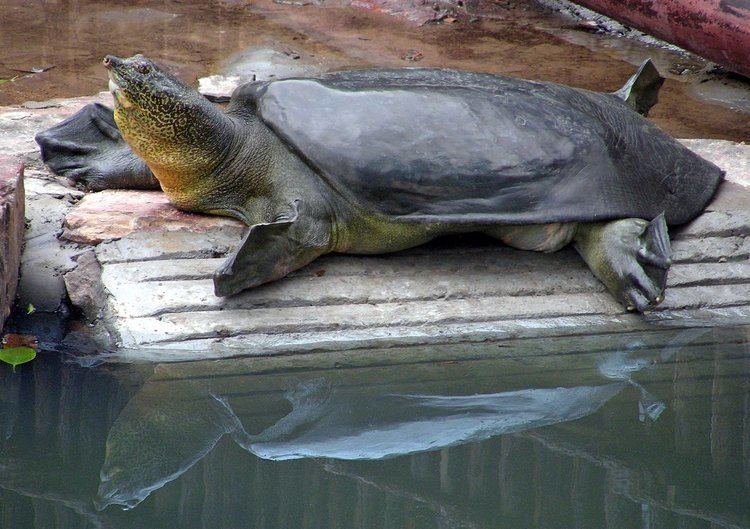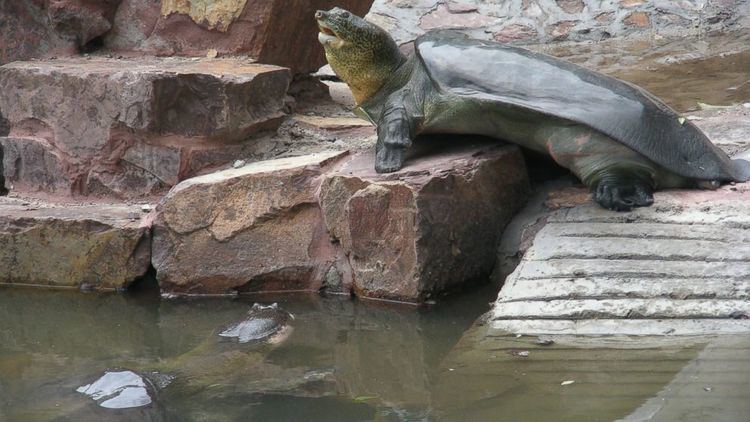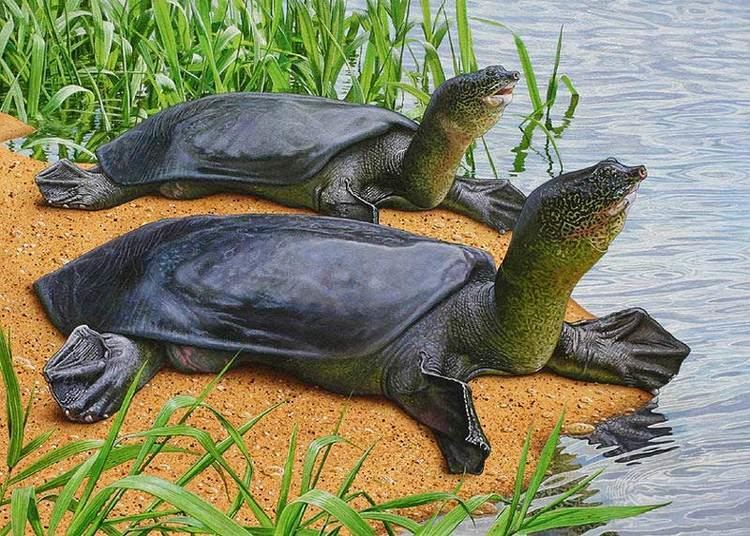Phylum Chordata Rank Species | Subphylum Vertebrata Subfamily Trionychinae Scientific name Rafetus swinhoei Higher classification Rafetus Order Turtle | |
 | ||
Similar Turtle, Rafetus, Trionychidae, Cantor's giant softshell t, Hoan Kiem turtle | ||
The Yangtze giant softshell turtle (Rafetus swinhoei ) is an extremely rare species of softshell turtle found in China. It is also known as the Red River giant softshell turtle, Shanghai softshell turtle, or Swinhoe’s softshell turtle. In Chinese, it is known as the speckled softshell turtle (Chinese: 斑鱉; Pinyin: bān bīe). Only three living individuals are known (a fourth having been reported dead in January 2016), and it is listed as critically endangered in the IUCN Red List. It is hoped that a pair at Suzhou Zoo in China will breed.
Contents
- Description
- Geographic range
- Diet
- Reproduction
- Scientific description and systematics
- Key threats
- Conservation efforts
- The legend of Kim Qui
- References

Description

The Yangtze giant softshell turtle is noted for its deep head with a pig-like snout and dorsally placed eyes. This critically endangered species holds the title of being the largest freshwater turtle in the world. It measures over 100 cm (39 in) in overall length and to 70 cm (28 in) in width, and can easily weigh up to 70–100 kg (150–220 lb). The average size of large turtle specimens (i.e. turtles weighing over 10 kg (22 lb)) that could be collected in the Yangtze River per one study was 25 kg (55 lb), although not all specimens were definitively identified as Rafetus. Its carapace, or shell, can grow larger than 50 cm (20 in), with the largest shell that could be found having measured 86 cm (34 in) in length. However, along the curve carapace lengths of up to 106 cm (42 in) have been reported and it is possible for the largest specimens (largely reported in Vietnam) to have weighed up 220 to 247.5 kg (485 to 546 lb). Its head can measure over 20 cm (7.9 in) in length and 10 cm (3.9 in) in width. The male is generally smaller than the female and has a longer, larger tail.
Geographic range

The Yangtze giant softshell turtle has been known to inhabit the Yangtze River and Lake Tai, situated on the border of Jiangsu and Zhejiang Provinces, in eastern China, and Gejiu, Yuanyang, Jianshui and Honghe in Yunnan Province in southern China. The last known specimen caught in the wild in China was in 1998 in the Red River between Yuanyang and Jianshui; it was then released. Only three living specimens are known, one at Dong Mo Lake Son Tay in Hanoi, Vietnam, (taxonomy questioned) and two in Suzhou zoo in China.

A specimen at the Beijing Zoo died in 2005, and another one at the Shanghai Zoo died in 2006; both of them were caught at Gejiu in the 1970s. In 1999, 2000, and 2005, turtles re-emerged from Hoan Kiem Lake in Hanoi and were seen by a large audience and caught on film. Only a single turtle was believed to be left in the lake. In April 2011, it was captured because it had open sores (possibly due to trash and pollution in the lake or injuries from fishing hooks or other turtles) that needed to be treated. It was reported dead in January 2016.
Diet
R. swinhoei eats fish, crabs, snails, water hyacinth, frogs, and leaves.
Reproduction

The Yangtze giant softshell turtle may lay from 60 to more than 100 eggs. It nests at night and during the morning.

A fertile female from Changsha Zoo was introduced to the only known male in China, a 100-year-old individual in Suzhou Zoo, in 2008. The female, who is over 80 years old, was said to settle in well after her 600-mile move, and biologists were optimistic for breeding success. The move was coordinated by the Wildlife Conservation Society and the Turtle Survival Alliance. In July 2013 National Geographic reported that in the sixth breeding season for the Suzhou mating pair, 80 eggs have been laid, but none fertile.
Scientific description and systematics
The species became known to Western science in 1873, when John Edward Gray, the turtle expert at the British Museum, described the specimen sent to him from Shanghai by English biologist Robert Swinhoe. He named the species Oscaria swinhoei, and described it as "the most beautiful species of Trionychidae that has yet occurred."
In 1880, the Shanghai-based French Jesuit Pierre Marie Heude obtained several specimens of this turtle, from the Huangpu River (near Shanghai) and Lake Tai (near Suzhou). He thought them sufficiently different from each other to describe them as five distinct species: Yuen leprosus, Yuen maculatus, Yuen elegans, Yuen viridis, and Yuen pallens. The genus name, Yuen, presumably comes from the Chinese 鼋 (transcribed yüen in the Wade-Giles system, or yuan in the modern Hanyu Pinyin), which means a large turtle.
Later zoologists classified these turtles as belonging to the Trionyx, Pelodiscus, and Pelochelys genera; in 1987, Meylan categorized this species under the Rafetus genus.
The placement of the related or conspecific Hoan Kiem turtle, Rafetus leloii, remains poorly known and controversial. Most herpetologists accept R. leloii is a junior synonym of the Yangtze giant softshell turtle, though some Vietnamese biologists, such as Ha Dinh Duc, who first described R. leloii, and Le Tran Binh, assert R. leloii to be distinct. Le points out genetic differences, as well as differences in morphology. However, Farkas et al. repeated their 2003 conclusion in 2011, attributing differences between specimens to age, and pointed out that the genetic sequences used were never sent to GenBank. They also criticized the fact that Le et al. violated ICZN Code by renaming the species from R. leloii to R. vietnamensis on the grounds of "appropriateness".
Key threats
The Yangtze giant softshell turtle is on the brink of extinction due to habitat loss, hunting for subsistence and local consumption, and the use of the carapace and bones in alternative medicine. Skulls are often kept as trophies. A recent plan to build hydropower cascade of 12 dams on the Red River in China may flood all of its habitat and change the ecosystem of lower Vietnam.
Conservation efforts
Conservation efforts are concentrated on breeding captive turtles in China and searching for live specimens in the wild. An agreement was made to transfer the only known remaining female specimen located at the Changsha Zoo to the Suzhou Zoo to breed with the male specimen there. Also, efforts are being made to improve conditions for breeding at both the Suzhou Zoo and Western Temple in Suzhou. A workshop on the Rafetus Conservation at Yunnan was held by CI-Shanshui. Local Chinese scientists are searching for the last existent individuals. The two specimens were able to produce two clutches of eggs, with over half of them being fertile, though unfortunately all of them perished before hatching. The Turtle Survival Alliance released a statement saying, "A number of the eggs had very thin shells, suggesting that the diet of the animals prior to breeding was not optimal.". The two turtle are now being prepared for another round of mating, while being fed a high-calcium diet in an effort to strengthen the eggs. Liu Jinde, the director of the zoo said, "We've worked very hard on this, We ought to succeed. The turtles are very healthy."
The scientists began preparing to mate the two once again in May 2009, which fell within this species' breeding season, but in the fall of 2009, the zoo announced that despite laying 188 eggs, the eggs were infertile and would not hatch. The Turtle Survival Alliance issued a statement explaining the infertility was due in part to the turtle's poor diet and the group expressed concern that the zoo's patrons had thrown trash into the turtle's enclosure that, if eaten, could endanger the health of the turtles. On June 15, 2010, the female laid a total of 63 eggs. Half of the eggs were left in the sand to incubate naturally, while the other half were moved to incubate at varying temperatures and humidities. Once again, they were infertile.
In 2015 artificial insemination was attempted, a first for this species. In May 2015, the female was successfully inseminated. Semen was extracted from the sedated male using electro-ejaculation. The female should lay the eggs a few weeks after and fertility of the eggs can be determined a couple weeks after laying. As of late July, the female had laid 2 clutches of eggs, totaling 89 eggs, but none were viable.
The legend of Kim Qui
The specimen (which may be a distinct species R. leloii) located in Hoan Kiem Lake, in Hanoi is thought to be the legendary Kim Qui (金龜), or Golden Turtle God, who has appeared at opportune moments throughout Vietnamese history. The golden turtle first appeared during the reign of King An Dương Vương (257-207 BC) and assisted the king in the construction of defenses for the ancient capital of Co Loa. When Co Loa was attacked, Kim Qui assisted the king in making a magical cross-bow that massively rained arrows upon the invaders in only a single shot. When the King's daughter conspired against her father, Kim Qui emerged again to inform An Duong Vuong of the betrayal; the king consequently killed his daughter and drowned himself in the sea.
In the 15th century, a gentry named Lê Lợi obtained a magical sword named Heaven's Will that a fisherman had pulled out of the lake. Lê Lợi used this sword to lead a rebellion against the Chinese armies that were in occupation of Vietnam. After overthrowing the Chinese rule and establishing the Lê Dynasty, the now-emperor Lê Lợi returned to the lake and Kim Qui emerged, then asked Lê Lợi to return the sword. The King drew the sword and hurled it toward Kim Qui. Kim Qui quickly caught the sword by his teeth, then submerged. Lê Lợi afterwards named the lake 'Lake of Returning Sword', or Hoan Kiem.
